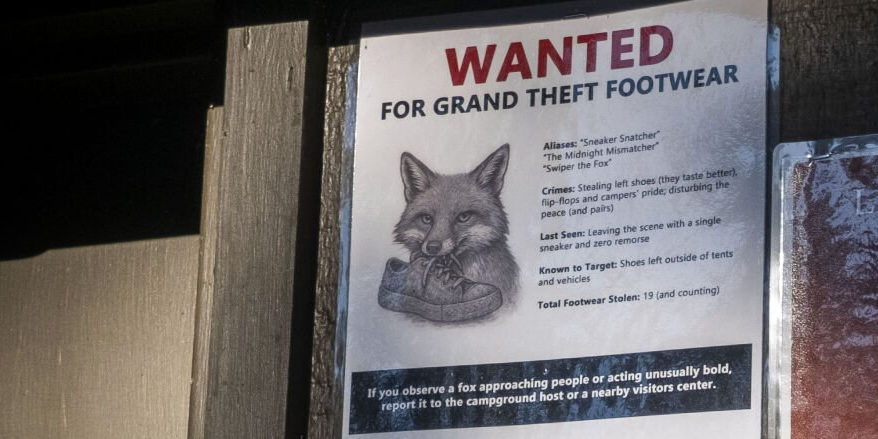Over the last several months, the summer campers at the Lizard Creek Campground in Grand Teton National Park have reported a series of crimes that appear be the work of a local criminal, reports Jackson Hole News & Guide. Mysteriously, shoes have been stolen from outside tents and campers. As of July 11, the count of missing shoes rose to 32. Amid this crime wave, the perpetrator or perpetrators remain at large, but park officials believe the primary suspect to be a shoe-stealing fox. Or, possibly, a crime ring of foxes.
Shoe Crime and Its Victims
Already, visitors to the park have given the thief (or thieves) several clever names. Some of the catchiest have been “Sneaker Snatcher,” “The Midnight Mismatcher” and “Swiper the Fox.” The shoes themselves have not been stolen in pairs, but, rather, just individual shoes. Park officials have urged are campers to keep their shoes in a secure location to prevent further theft. Keeping shoes inside a bear box, a vehicles, or, at the very least, a tent are offered as precautions.
However, visitors to the area seem to have taken advice opposite what is being recommended. Instead, many leave their shoes out in order to get a glimpse of the furry felon. Emily Davis, a park spokesperson, says that warnings have been put out to educate guests, not encourage any interaction with the shoe-stealing fox. Nonetheless, the playful wanted posters in the Lizard Creek Campground seem to foster the opposite approach.
Likewise, this video on Grand Teton National Park’s Instagram page gets further in on the fun. In it, campers put out shoes as offerings.
View this post on Instagram
Officials are perplexed as to why the animal is stealing the shoes. In the text of the Instagram post, the caption reads, “What does the fox do with the shoes? We still don’t know … Maybe it’s a toy. Maybe it’s fashion.” Understandably, the story itself has even garnered a wider audience, being reported on July 16 in USA Today.
Suspects and Motives
Speaking to park officials, the Cowboy State Daily reports that a collared fox has been documented in the area, but it isn’t known if this is the culprit. The collar is part of a University of Wyoming study that is tracking a number of animals including foxes, coyotes, and wolves to evaluate the wolf recovery in the park and document the behaviors of the animals. Among the potential motives for the shoe-stealing fox, bringing toys back to their young to play with, common among canines, has been considered.
Foxes dwell among the humans in the area for a variety of reasons. The species often find human presence a protection against predators and discover humans to be easy pickings when it comes to handouts. Unfortunately, this can be a bigger problem for the fox. Animals that should be wild but become conditioned to see humans as an easy mark for food are actually euthanized.
“Where we as a park get concerned is, ‘When do you cross that line from habituation to food conditioning and start associating people with food?’” asks biologist John Stephenson, a Grand Teton wildlife biologist, sharing to the Cowboy State daily.
There are foxes in the park that have become used to humans and tolerate us. These animals are typically not a threat, according to Stephenson.
The Real Dangers of Food Conditioning
When foxes become food-conditioned, problems arise. Food-conditioned animals are a danger to both people and themselves. The Grand Teton National Park ark staff in 2018 euthanized a food-conditioned fox that had been observed walking from car to car begging for food. In 2024, a rabid fox attacked humans three separate times in Arizona’s Saguaro National Park.
View this post on Instagram
Food-conditioned animals can spread diseases to humans and their pets. Part of the process involves evaluating whether the creature loiters in developed areas for extended times showing it no longer considers humans a threat.
Park officials are urging campers to store all food and scented items, including shoes, toiletries, and pet food, in bear boxes or hard-sided vehicles at all times, even daytime.
Visitors should always maintain a distance of at least 25 yards from foxes. The larger the predator the greater the distance. For example, the park recommends a distance 100 yards from larger predators like bears and wolves.

Leave a Reply